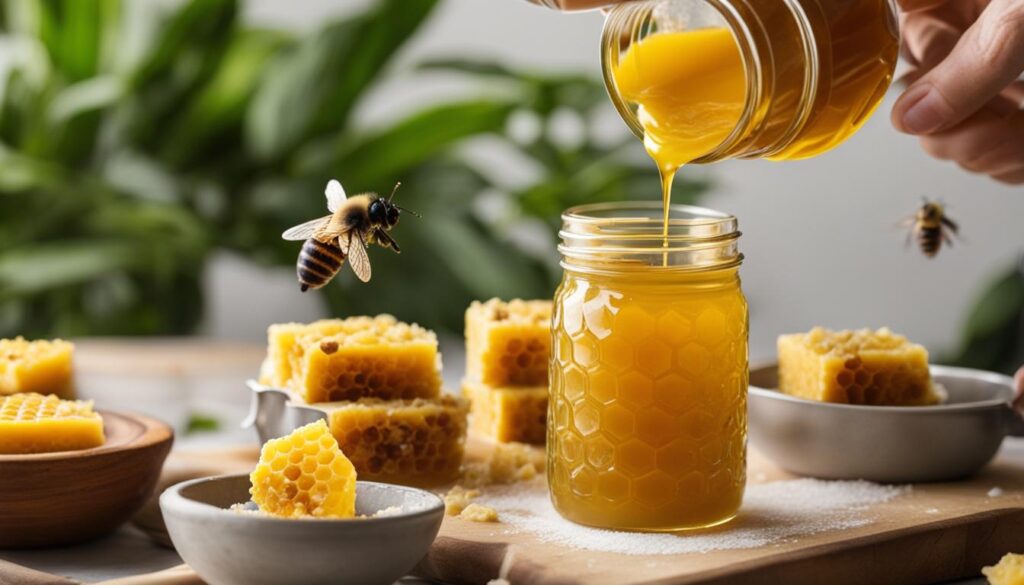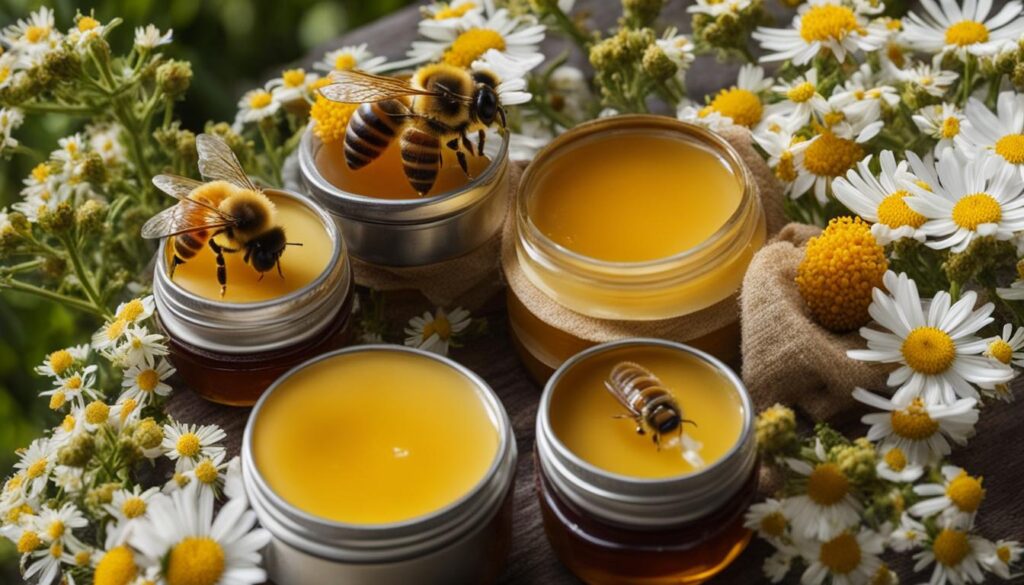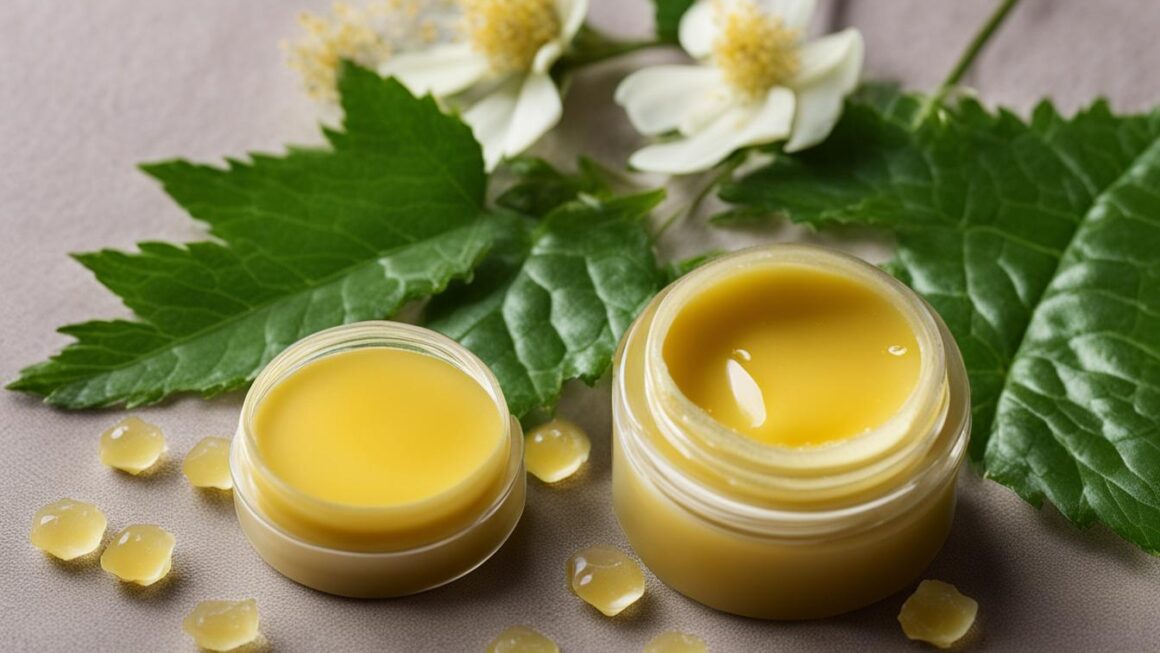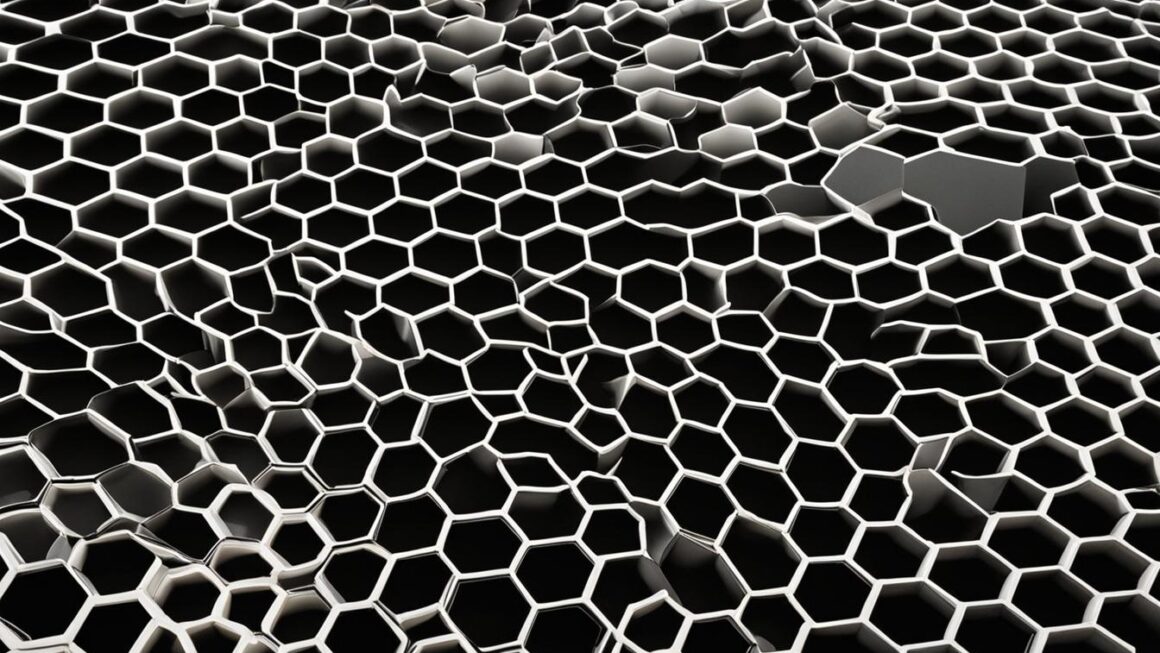Learn how to make your own homemade beeswax lip balm using natural and toxin-free ingredients. This recipe is easy to follow and takes less than 15 minutes to make. Beeswax lip balm has moisturizing, healing, and protective properties, making it perfect for soothing dry and chapped lips. By avoiding harmful ingredients found in commercial lip balms, you can create a natural and nourishing product to keep your lips healthy.
Key Takeaways:
- Making your own beeswax lip balm allows you to control the ingredients and avoid harmful chemicals found in commercial options.
- Beeswax is moisturizing, healing, and protective, making it an excellent ingredient for lip balm.
- Choosing the right carrier oils and essential oils allows for customization and personalized scents and flavors.
- Store your homemade lip balm in a cool, dry place to maintain its freshness and effectiveness.
- Beeswax has various other uses in natural skincare, such as in beeswax wraps and candles.
Why Homemade Beeswax Lip Balm is Better Than Store-Bought
When it comes to taking care of our lips, there are plenty of options available in the market. But why settle for store-bought lip balms when you can create your own homemade beeswax lip balm? There are several advantages to making your own lip balm, and it’s worth exploring the benefits.
- Natural Lip Balm Advantages: Homemade lip balm allows you to have complete control over the ingredients. Unlike commercial options, you can choose natural and toxin-free ingredients that are safe for your lips. This means avoiding harmful substances like parabens, petroleum jelly, synthetic colors, and chemical sunscreens that may be present in store-bought lip balms.
- Benefits of Homemade Lip Balm: Homemade lip balm offers a personalized experience. You can customize the scent, flavor, and even the texture of your lip balm according to your preferences. Whether you prefer a subtle fragrance or a burst of flavor, the possibilities are endless when you create your own lip balm.
- Harmful Ingredients in Commercial Lip Balm: Commercial lip balms often contain ingredients that can do more harm than good. These ingredients may cause dryness, irritation, or allergic reactions. By making your own lip balm, you can carefully select each ingredient and ensure that it is safe and beneficial for your lips.
By choosing homemade beeswax lip balm over store-bought options, you can enjoy the natural advantages of a personalized product while avoiding harmful ingredients. Crafting your own lip balm is a simple and rewarding process that allows you to prioritize the health and well-being of your lips.
Table: Homemade vs Store-Bought Lip Balm
| Factors | Homemade Lip Balm | Store-Bought Lip Balm |
|---|---|---|
| Ingredients | Customizable and natural | May contain harmful chemicals |
| Personalization | Scent, flavor, and texture can be personalized | Limited options |
| Effectiveness | Nourishing and hydrating | May provide temporary relief |
| Price | Cost-effective in the long run | Varies depending on the brand |
The Benefits of Beeswax in Lip Balm
Beeswax is a key ingredient in lip balm formulations, offering a range of benefits for the health and appearance of your lips. Its moisturizing properties help to hydrate and nourish the delicate skin, leaving your lips soft and supple. Beeswax also has healing properties that can soothe and repair chapped or damaged lips, providing relief from dryness and discomfort. Additionally, beeswax forms a protective barrier on the lips, sealing in moisture and shielding them from harsh environmental factors such as wind and cold weather.
The moisturizing properties of beeswax can be attributed to its ability to lock in moisture and prevent dehydration. When applied to the lips, beeswax creates a thin, breathable layer that helps to retain the natural moisture produced by the skin, effectively preventing dryness and reducing the risk of chapping. This natural barrier also helps to protect the lips from external irritants, such as pollutants and allergens, which can cause dryness and sensitivity.
Beeswax is a versatile ingredient that provides moisturizing, healing, and protective properties, making it an excellent choice for lip balm formulations. Its natural and sustainable nature also adds to its appeal, making it a popular ingredient in natural and organic skincare products.
In addition to its moisturizing and healing properties, beeswax also offers a protective shield for the lips. By forming a barrier on the surface of the lips, beeswax helps to prevent moisture loss and protect against external factors that can cause dryness and damage. This protective layer can be especially beneficial during extreme weather conditions or in dry environments, providing an extra level of defense for your lips.
| Benefit | Explanation |
|---|---|
| Moisturizing | Beeswax helps to retain moisture and prevent dehydration, keeping the lips soft and supple. |
| Healing | Beeswax has soothing properties that can help to repair chapped or damaged lips, providing relief and promoting healing. |
| Protective | Beeswax forms a barrier on the lips, protecting them from external irritants and preventing moisture loss. |
Choosing the Right Carrier Oils for Beeswax Lip Balm
When it comes to creating your own beeswax lip balm, choosing the right carrier oils is essential. Carrier oils not only help to moisturize and nourish the lips but also play a crucial role in determining the overall texture and consistency of the balm. Here are some popular carrier oils that work well in combination with beeswax:
- Coconut oil: Known for its moisturizing and antimicrobial properties, coconut oil is a popular choice for lip balm recipes. It helps to hydrate and soften the lips while providing a protective barrier against moisture loss.
- Almond oil: Rich in vitamin E, almond oil is a nourishing choice for lip balm. It can help improve the appearance of the lips and provide a smooth and creamy texture to the balm.
- Olive oil: Another excellent option for lip balm, olive oil offers antioxidant benefits and helps to soothe and moisturize the lips. It is particularly beneficial for dry and chapped lips.
Each carrier oil has its own unique properties, so you can choose the one that best suits your preferences and needs. Additionally, you can experiment with different combinations of carrier oils to create a personalized lip balm recipe that works perfectly for you.
Comparing Properties of Carrier Oils:
| Carrier Oil | Moisturizing Properties | Healing Properties | Protective Properties |
|---|---|---|---|
| Coconut Oil | ✓ | – | ✓ |
| Almond Oil | ✓ | – | – |
| Olive Oil | ✓ | – | ✓ |
“I love using a combination of coconut oil and almond oil in my homemade lip balm. It creates a smooth and moisturizing formula that keeps my lips soft and protected throughout the day.” – Amy, Lip Balm Enthusiast
Remember to use high-quality carrier oils that are suitable for cosmetic use. Cold-pressed, organic options are often preferred for their purity and effectiveness. By selecting the right carrier oils, you can create a nourishing and hydrating beeswax lip balm that will keep your lips healthy and moisturized.
Essential Oils and Flavor Oils for Scent and Flavor in Lip Balm
You can enhance the scent and flavor of your beeswax lip balm by adding essential oils or flavor oils. Essential oils offer natural fragrance options like lavender or peppermint, while flavor oils provide taste sensations such as cake batter or cotton candy. It’s important to choose cosmetic-grade, pure oils and follow safe usage guidelines. These oils can add a pleasant sensory experience to your homemade lip balm.
When incorporating essential oils into your lip balm recipe, it’s crucial to consider their potency and potential effects on the skin. Essential oils are highly concentrated and should be used sparingly to avoid skin irritation. It’s recommended to start with a small amount, such as a few drops, and gradually increase the concentration if desired. Additionally, certain essential oils have specific benefits for the lips. For example, peppermint oil has a cooling effect and can help soothe chapped lips, while lavender oil has calming and healing properties.
Essential Oils for Lip Balm:
- Lavender
- Peppermint
- Orange
- Lemon
- Grapefruit
Flavor oils, on the other hand, are specifically designed to add taste to lip balms without compromising their quality or safety. These oils come in a wide variety of flavors, allowing you to create lip balms that cater to different preferences. Whether you prefer fruity, minty, or sweet flavors, there is a flavor oil available to suit your needs. It’s important to note that flavor oils are intended for lip balm use only and should not be ingested.
Using essential oils and flavor oils in your homemade lip balm can not only provide a pleasant aroma and taste but also offer additional benefits for your lips. However, it’s crucial to choose high-quality oils and use them in appropriate concentrations to ensure the safety and effectiveness of your lip balm.
Flavor Oils for Lip Balm:
- Strawberry
- Vanilla
- Cherry
- Mint
- Coconut
| Key Benefits of Essential Oils | Key Benefits of Flavor Oils |
|---|---|
| Healing and soothing properties | Wide range of flavors |
| Natural fragrance options | No compromise on quality or safety |
| Personalized experience | Cater to different preferences |
Where to Find Pure Beeswax for Homemade Lip Balm
When it comes to creating your own homemade lip balm, using pure and natural beeswax is essential. Sourcing high-quality beeswax ensures that your lip balm is free from impurities and additives. To find pure beeswax, it is best to buy directly from beekeepers. This not only guarantees the authenticity of the beeswax but also supports local farmers and beekeeping communities. Here are some places where you can find pure beeswax:
- Local Farmers’ Markets: Many beekeepers sell their products, including beeswax, at local farmers’ markets. This allows you to connect directly with the beekeeper and inquire about their beekeeping practices and the purity of their beeswax.
- Beekeeping Associations: Beekeeping associations often have directories or online platforms where beekeepers advertise their products. These associations can provide valuable information about the beekeepers, their beeswax, and their commitment to sustainable beekeeping practices.
- Online Marketplaces: Several online platforms connect beekeepers directly with customers. These platforms offer a wide range of pure beeswax products, allowing you to choose from different sizes and quantities based on your needs.
When purchasing pure beeswax, it is important to look for clear descriptions and certifications that ensure the beeswax is free from pesticides, chemicals, and other contaminants. By buying pure beeswax directly from beekeepers, you can have peace of mind knowing that you are using a natural and sustainable ingredient in your homemade lip balm.
| Place to Find Pure Beeswax | Description |
|---|---|
| Local Farmers’ Markets | Connect with beekeepers directly, inquire about beekeeping practices and purity of beeswax |
| Beekeeping Associations | Directories or online platforms that provide information about beekeepers and their beeswax |
| Online Marketplaces | Platforms that connect beekeepers with customers, offering a wide range of pure beeswax products |
Step-by-Step Guide to Making Beeswax Lip Balm
Creating your own beeswax lip balm is a simple and rewarding process. With just a few ingredients and easy-to-follow steps, you can make a natural, soothing balm that will keep your lips hydrated and healthy. Follow this step-by-step guide to learn how to make your own homemade lip balm.
Ingredients:
- 2 tablespoons of beeswax pellets
- 2 tablespoons of carrier oil (such as coconut oil, almond oil, or olive oil)
- 10-15 drops of essential oil or flavor oil (optional for scent and flavor)
Instructions:
- In a small heatproof bowl or measuring cup, combine the beeswax pellets and carrier oil.
- Place the bowl or cup in a saucepan filled with a couple of inches of water. Create a double boiler by heating the water gently on the stove.
- Stir the mixture occasionally until the beeswax pellets have completely melted and the ingredients are well combined.
- If desired, add 10-15 drops of essential oil or flavor oil to the mixture and stir well.
- Carefully pour the melted mixture into lip balm tubes or tins. Allow it to cool completely and solidify before use.
Tips:
- Experiment with different carrier oils and essential oils to create your desired lip balm consistency and scent.
- Use a disposable pipette or small dropper to transfer the melted mixture into lip balm containers for easier pouring.
- Label and date your homemade lip balm to keep track of its shelf life. It can typically last for up to a year when stored properly.
| Ingredient | Benefit |
|---|---|
| Beeswax | Moisturizes and protects the lips |
| Carrier oil | Hydrates and nourishes the lips |
| Essential oil or flavor oil | Adds scent and flavor to the lip balm |
Follow this step-by-step guide and enjoy the process of creating your own beeswax lip balm. With this natural and customizable product, you can keep your lips soft, smooth, and free from harsh chemicals. Say goodbye to dry and chapped lips and hello to a nourishing and soothing lip balm made with love.

Tips for Storing and Using Beeswax Lip Balm
Proper storage is essential for maintaining the freshness and effectiveness of your beeswax lip balm. Here are some tips to help you store and use your lip balm effectively:
- Store it in a cool, dry place away from direct sunlight or heat. Excessive heat can cause the lip balm to melt and lose its texture.
- Avoid exposing the lip balm to excessive moisture, as it can lead to mold growth and spoil the product.
- Keep the lip balm container tightly sealed when not in use to prevent air exposure, which can cause the lip balm to dry out.
- Use clean fingers or a lip brush to apply the lip balm to your lips. This helps maintain the hygiene of the product and prevents the introduction of bacteria.
Additionally, it’s important to be aware of the shelf life of your lip balm. While homemade beeswax lip balms typically last for several months, it’s best to check for any changes in texture, smell, or color. If you notice any signs of spoilage or deterioration, it’s advisable to discard the lip balm and make a fresh batch.
By following these tips, you can ensure that your beeswax lip balm remains fresh, effective, and enjoyable to use.
Other Uses for Beeswax in Natural Skincare
Beeswax is not only a valuable ingredient in homemade lip balm but also has a wide range of uses in natural skincare. Its unique properties make it a popular choice for various skincare products. Here are some other ways you can incorporate beeswax into your skincare routine:
Candles:
Beeswax candles are a sustainable and natural alternative to conventional candles. They burn cleaner and produce less soot, making them ideal for creating a cozy and toxin-free ambiance in your home. Beeswax candles also emit a subtle honey scent, adding a pleasant aroma to any space.
Skincare Products:
Beeswax is a common ingredient in many skincare products, including creams, lotions, and balms. Its moisturizing and protective properties help to soothe dry skin and create a barrier against environmental irritants. Beeswax is especially beneficial for those with sensitive or dry skin, as it helps to retain moisture and promote overall skin health.
Wraps:
Beeswax wraps are a sustainable and eco-friendly alternative to plastic wrap. Made by infusing fabric with beeswax, these wraps can be used to cover and store food, reducing the need for single-use plastics. Beeswax wraps are reusable, washable, and biodegradable, making them a perfect choice for anyone looking to reduce their environmental impact.
| Other Uses for Beeswax | Benefits |
|---|---|
| Candles | Cleaner burning, pleasant scent |
| Skincare Products | Moisturizing, protective, suitable for sensitive skin |
| Wraps | Sustainable, reusable, biodegradable |
Conclusion
Beeswax is a versatile ingredient that goes beyond lip balm. From candles to skincare products and eco-friendly wraps, beeswax offers a range of benefits for both personal care and sustainable living. By embracing the various uses of beeswax, you can enhance your skincare routine and make conscious choices that align with your values.

Recommended Brands for Natural Beeswax Lip Balm
If you prefer to buy natural lip balm instead of making it yourself, there are several recommended brands available. These brands prioritize clean and non-toxic ingredients, ensuring that you can nourish your lips without any harmful additives. Here are some top choices:
Beautycounter’s Lip Conditioners: Beautycounter offers a range of lip conditioners made with organic and nourishing ingredients. Their lip balms are free from synthetic fragrances and harmful chemicals, making them a safe and clean choice for your lips.
Primally Pure Lip Balm: Primally Pure is known for its high-quality, natural skincare products, and their lip balms are no exception. Made with organic ingredients, such as beeswax, coconut oil, and shea butter, their lip balms provide effective hydration without any synthetic additives.
Perfect Supplements Lip Nutrients: Perfect Supplements offers lip balms enriched with nourishing ingredients like beeswax, coconut oil, and vitamin E. Their lip balms are free from parabens, petroleum, and artificial colors, ensuring a clean and non-toxic product for your lips.
These recommended brands provide a wide range of flavors and scents, allowing you to find the perfect natural lip balm for your preferences. By choosing these clean and non-toxic options, you can prioritize the health and well-being of your lips while enjoying the soothing and hydrating benefits of beeswax lip balm.
Comparison of Recommended Natural Lip Balm Brands
| Brand | Key Features | Ingredients | Price Range |
|---|---|---|---|
| Beautycounter’s Lip Conditioners | Organic, non-toxic, synthetic fragrance-free | Beeswax, coconut oil, shea butter | $10 – $30 |
| Primally Pure Lip Balm | High-quality, natural, organic | Beeswax, coconut oil, shea butter | $8 – $20 |
| Perfect Supplements Lip Nutrients | Nourishing, clean, free from parabens and petroleum | Beeswax, coconut oil, vitamin E | $12 – $25 |
Table: Comparison of Recommended Natural Lip Balm Brands.
Conclusion
Making your own beeswax lip balm is a rewarding and beneficial process. By utilizing natural and toxin-free ingredients, you can create a product that is both soothing and hydrating for your lips. Beeswax provides numerous benefits, including moisturizing, healing, and protective properties, making it an ideal ingredient for lip balm.
Choosing the right carrier oils and essential oils allows for customization, so you can create a lip balm that suits your needs and preferences. Whether you prefer coconut oil, almond oil, or olive oil, each carrier oil offers unique properties for nourishing and improving the appearance of your lips. Similarly, essential oils and flavor oils can add delightful scents and flavors to enhance your lip balm experience.
If making your own lip balm isn’t your cup of tea, there are several recommended brands available that offer natural and non-toxic options. Beautycounter’s Lip Conditioners, Primally Pure Lip Balm, and Perfect Supplements Lip Nutrients are all excellent choices that prioritize clean ingredients. These brands provide a range of flavors and scents to indulge your lips in a luxurious and nourishing experience.
Whether you choose to make your own lip balm or purchase from recommended brands, the important thing is to prioritize natural and nourishing options for your lips. Beeswax lip balm is a reliable solution for soothing and protecting dry and chapped lips, ensuring long-lasting hydration and leaving your lips feeling soft and supple. Start creating your own naturally soothing lip balm and experience the benefits now!
FAQ
What are the benefits of making homemade beeswax lip balm?
Homemade lip balm allows you to control the quality and purity of the ingredients, avoiding harmful chemicals found in commercial options. You can also customize the scent and flavor to create a personalized experience.
Why is beeswax a beneficial ingredient in lip balm?
Beeswax has natural moisturizing properties, can heal chapped lips, and forms a protective barrier to prevent moisture loss and protect against irritants.
What are the best carrier oils for beeswax lip balm?
Popular choices for carrier oils include coconut oil, almond oil, and olive oil. Coconut oil provides antimicrobial properties, almond oil contains vitamin E, and olive oil has antioxidant benefits.
Can I add scent and flavor to my homemade lip balm?
Yes, you can enhance the scent and flavor of your lip balm by adding essential oils or flavor oils. Be sure to choose cosmetic-grade, pure oils and follow safe usage guidelines.
Where can I find pure beeswax for my homemade lip balm?
It’s best to source pure beeswax directly from beekeepers to ensure its authenticity and purity. Buying directly from beekeepers also supports small farmers.
How do I make homemade beeswax lip balm?
Start by melting the beeswax and carrier oil together, then add any desired essential oils or flavor oils. Pour the mixture into lip balm tubes or tins and let them cool and solidify.
How should I store and use my beeswax lip balm?
Store your lip balm in a cool, dry place away from sunlight or heat. Avoid exposing it to excessive moisture or temperature changes. Use clean fingers or a lip brush for hygienic application.
What are some other uses for beeswax in natural skincare?
Beeswax can be used in beeswax wraps for preserving food, beeswax furniture polish for restoring wood furniture, and beeswax candles for natural lighting.
Are there recommended brands for natural beeswax lip balm?
Yes, some recommended brands include Beautycounter’s Lip Conditioners, Primally Pure Lip Balm, and Perfect Supplements Lip Nutrients.
Is making homemade beeswax lip balm worth it?
Absolutely! Making your own lip balm allows you to prioritize natural and nourishing ingredients, creating a product that is soothing and hydrating for your lips.




